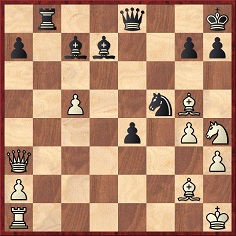
Edward Winter
Few players are slow to claim a brilliancy, but Edward Lasker once uncorked a superb move – and did not even realize it. Heidenfeld’s Lacking the Master Touch (pages 10-11) discusses a position from the game Ed. Lasker-Marshall, New York tournament, 30 March 1924:

Position after 27...Ne7-f5
Lasker played 28 Bf4, which helped to relieve his difficult position, although he later lost the game through subsequent sins. But, as Heidenfeld, points out:
‘What Lasker executed with the move 28 B-B4 is one of the very rare anti-Turtons ever seen in play, though it is a well-known combination in problem composition. It consists in forcing the attacker who wishes to double two pieces on the same gait in such a way as to have the stronger piece in front and the weaker behind (called the Turton in the jargon of problemists) into playing the weaker piece across the so-called “critical square” (here Black’s K4) and thus into reversing the planned line-up ...
... Now it is absolutely impossible for even the most modest chess master who knows of these contexts and has the good fortune to bring off such a rare combination, not to crow over it and dismiss the game, as Lasker does, with the words: “Marshall made a complicated combination which permitted me to equalize, when he could have won within a few moves. I lost the game through a blunder in the seventh hour of play ...” Thus, though Edward Lasker included a chapter on problems in his work Chess for Fun & Chess for Blood, his knowledge of this field is clearly deficient – otherwise he would have hailed his game against Marshall as an extraordinary “find” – just as I am doing now. Without a record of this game the literature of chess would be distinctly poorer.’
Presumably the fact that Lasker lost the game helped him shut the brilliancy from his mind. Alekhine in the tournament book merely remarks that after 27...Ne7-f5, ‘White now defends himself capitally’.
Any more examples of the anti-Turton theme in actual play, or instances of a master never realizing how clever he had been?
(553)
From Michael McDowell (Westcliff-on-sea, England):
‘I was very interested in C.N. 553 since I have a small collection of game positions featuring problem themes, although up to now no example of an anti-Turton. It is curious to note that the second brilliancy prize winner from New York, 1924 (Marshall-Bogoljubow) featured an example of the Turton theme (18 Bb1 Bd7 19 Qc2).’
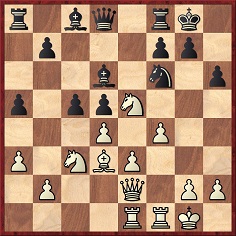
Position after 17...c6-c5
Our correspondent later pointed out that a lateral anti-Turton occurred in actual play in the game Lucarelli-Carra, Bologna, 1932; see page 124 of Modern Chess Tactics by L. Pachman (London, 1970):
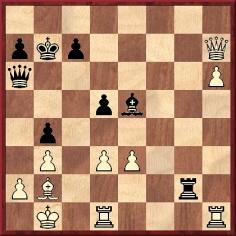
If 1 d4 then 1...Qe2. White therefore played 1 Rd2 Rxd2 2 d4 Qe2 3 Bc1, and Black resigned.
(681)
In C.N. 5350 we reproduced the above two items and asked, without result, whether the full game-score of the Lucarelli-Carra game was available.
The game-score has yet to be found, but is 1932 the correct year for the hunt? Michael Clapham (Ipswich, England) points out that when the position was discussed on pages 39-40 of The Chess Sacrifice by Vladimir Vuković (London, 1968) the date given was 1933.
(5644)
Jens Askgaard (Køge, Denmark) writes:
‘The position from the game Lucarelli-Carra appears on page 109 of Schackkavalkad by Kurt Richter (Stockholm, 1949), translated from the original Kurzgeschichten um Schachfiguren (Berlin, 1947):
The date is given as 1933. Instead of Black resigning after 1 Rd2 Rxd2 2 d4 Qe2 3 Bc1, the book says that White won easily thanks to his strong passed pawn on h6.
I would add that 2...Qe2 is a losing mistake for Black. Instead, he could have played the anti-anti-Turton move 2...Rf2, or 2...Bh2, which my computer suggests as the best move.’
The position was on page 101 of the 1947 original edition. Had Richter already used it elsewhere?
(12086)
Martin van Essen (Enschede, the Netherlands) offers a third specimen of the anti-Turton theme in over-the-board play: Black’s 15th move in the game between Yosef Porath and Bent Larsen at the 1956 Olympiad in Moscow.
1 Nf3 f5 2 c4 Nf6 3 Nc3 g6 4 b3 Bg7 5 Bb2 d6 6 d4 c6 7 e3 Qa5 8 a3 O-O 9 Be2 e5 10 b4 Qc7 11 d5 h6 12 c5 e4 13 Nd4 dxc5 14 Qb3 cxd4 15 d6+
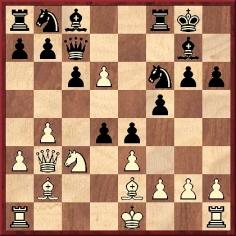
15...Be6 16 Qxe6+ Qf7 17 Qxf7+ Rxf7 18 exd4 Rd7 19 d5 Nxd5 20 Bc4 Kh7 21 Bxd5 Bxc3+ 22 Bxc3 cxd5 23 g4 Rxd6 24 gxf5 gxf5 25 Rd1 Nc6 26 b5 Nd8 27 f3 Ne6 28 fxe4 fxe4 29 Rf1 Ng5 30 Rf5 d4 31 h4 Nf3+ 32 Ke2 Rc8 33 Bb4 Rg6 34 White resigns.
The game has been published on, for instance, page 167 of Olimpiady Szachowe 1924-1970 by S. Gawlikowski (Warsaw, 1972).
It is a different illustration of the anti-Turton theme from the pair given in C.N. 5350. The only alternative to 15...Be6 is 15...Qf7, after which 16 Bc4 wins. The effect of that bishop move is thus nullified by drawing the queen beyond the critical square c4.
Michael McDowell is reminded of the following composition by E.E. Zepler in Deutsches Wochenschach, 1923:
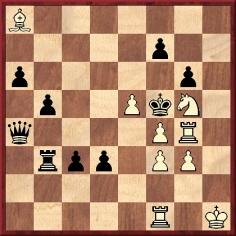
Mate in five
Mr McDowell comments:
‘If White tries 1 Rh4, threatening 2 Be4+ Qxe4 3 fxe4 mate, Black has the defence 1...Rb4 2 Be4+ Rxe4 3 fxe4+ Qxe4+, preventing 4 g4 mate. White therefore opens with 1 Bb7, forcing 1...Qc4, and now the main plan works: 2 Rh4 Rb4 3 Be4+ Qxe4 4 fxe4+ Rxe4 5 g4.’
(5512)
To the Chess Notes main page.
To the Archives for other feature articles.
Copyright Edward Winter. All rights reserved.